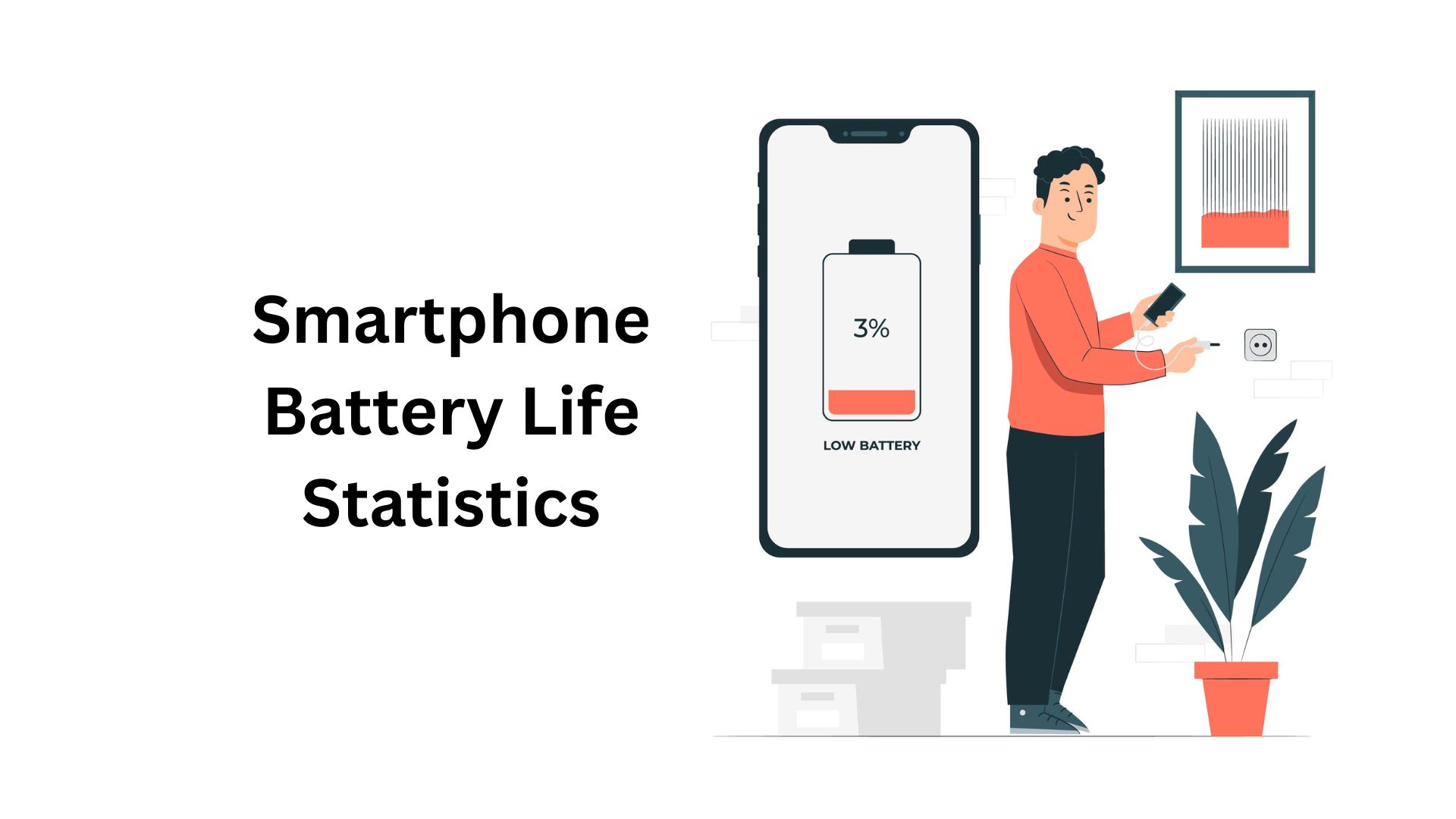Student Stress Statistics By Factors, Gender Differences, Social Media And Methods

Updated · Mar 24, 2025


TABLE OF CONTENTS
- Introduction
- Editor’s Choice
- Common Student Stress Factors Statistics
- High School Students Bullying Statistics
- Common Health Conditions in College Students Statistics
- Gender Differences in Stress Levels Statistics
- How Social Media Increases Stress Among Students
- Methods Used by Students to Reduce Stress
- Conclusion
Introduction
Student Stress Statistics: In 2025, student stress is a serious issue as academic pressure, social expectations, and mental health struggles continue to affect learners at all levels. With increasing schoolwork, college demands, and extracurricular activities, many students face high levels of anxiety, exhaustion, and burnout. Studies show that heavy workloads, money problems, and the rise of online learning play a big role in student stress.
On top of that, worries about future careers and societal expectations add even more pressure. Understanding these statistics is important for teachers, parents, and policymakers to create better support systems that help students succeed while maintaining their well-being. We shall shed more light on Student Stress Statistics through this article.
Editor’s Choice
- Around 33% of students think about leaving college due to financial difficulties.
- Student Stress Statistics stated that almost 74% of college students say that money problems are a major source of stress.
- Only 39.1% of students feel fully rested just once or twice a week.
- 70% of teenagers (ages 13-17) in the U.S. say that anxiety and depression are serious problems among their friends.
- 75% of high school students often feel bored, angry, sad, scared, or stressed while in school.
- On a 10-point stress scale, where adults rate their stress at 3.8, teens report a higher level of 5.8.
- 75% of high schoolers and 50% of middle schoolers regularly feel overwhelmed by schoolwork.
- Nearly 32% of teens deal with extreme stress during the school year.
- Student Stress Statistics stated that almost 26% of teenagers use drugs or alcohol to cope with stress.
- 30% of teens feel sad or depressed because of high-stress levels.
- 23% of teens skip meals due to stress.
- 34% of teens think their stress will increase in the next year.
- Stress & Sleep Issues Among College Students
- Nearly 40% of U.S. college students feel tired most days due to lack of sleep.
- 25% of students say not getting enough sleep hurts their grades and ability to meet deadlines.
- 45% of college students report feeling higher than average stress.
- Only 9% of students say they have little to no stress.
- 3% of college students deal with moderate stress levels.
- One year after the COVID-19 pandemic, 80% of students are still feeling stressed.
- Around 63% of students rely on video calls to manage their stress.
- 31% of students say that exams and midterms are their biggest stressors.
- Almost 64.5% of students struggling with relationship issues experience stress because of them.
Common Student Stress Factors Statistics
Stress can come from many different sources, and students often feel overwhelmed by more than just tests and grades. Moving away from home, adjusting to a new social life, and being separated from family and childhood friends add to the pressure. On top of that, students are expected to handle adult responsibilities like budgeting, loans, and job hunting—all while trying to succeed in school.
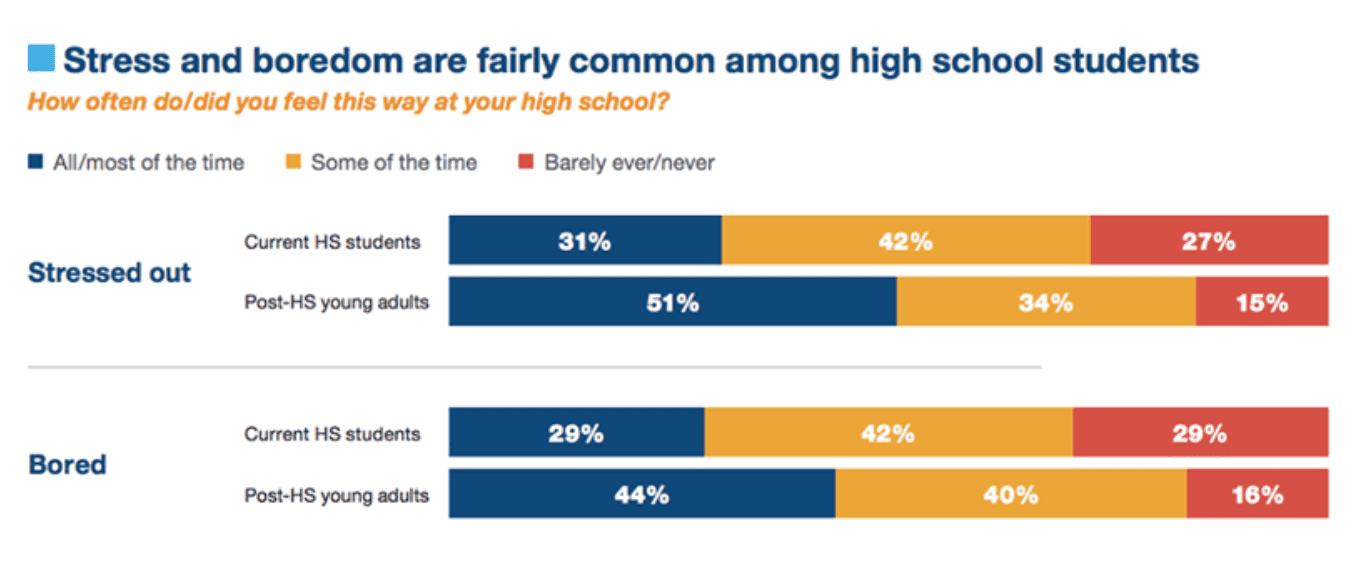 (Source: the74million.org)
(Source: the74million.org)
#1. Academic Pressure
- 31% of U.S. students say final exams and midterms are their biggest stressors.
- 23% feel overloaded by classwork and assignments.
- 13% struggle with stress caused by homework.
- 5% of college students admit that stress has negatively affected their academic performance in the last year.
- 5% say anxiety has also hurt their grades.
- Student Stress Statistics stated that almost 61% of middle schoolers feel intense pressure to get top grades.
- 29% worry about their looks.
- Almost 28% feel pressured to fit in with their peers.
- 21% stress over extracurricular activities and sports performance.
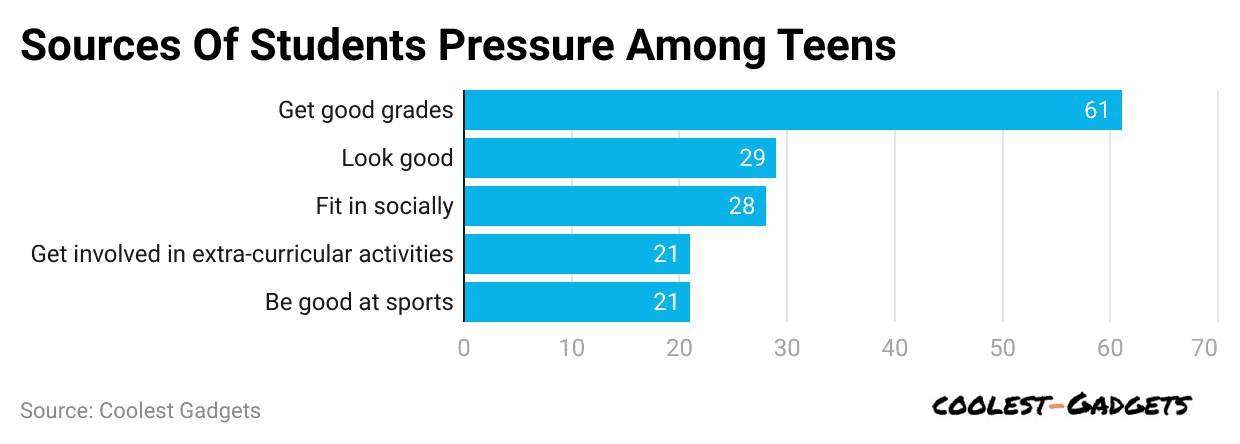 (Reference: research.com)
(Reference: research.com)
- Student Stress Statistics stated that almost 29% of college students in the U.S. have experienced bullying.
- 37% of students aged 12 to 17 have been cyberbullied in middle and high school.
- 24% of female students face bullying at school, compared to 17% of male students.
- Nearly 6% of boys report being physically bullied, while only 4% of girls say the same.
- 18% of female students have been the target of rumours, compared to 9% of male students.
- 7% of girls have been left out of activities on purpose, while 4% of boys have faced the same treatment.
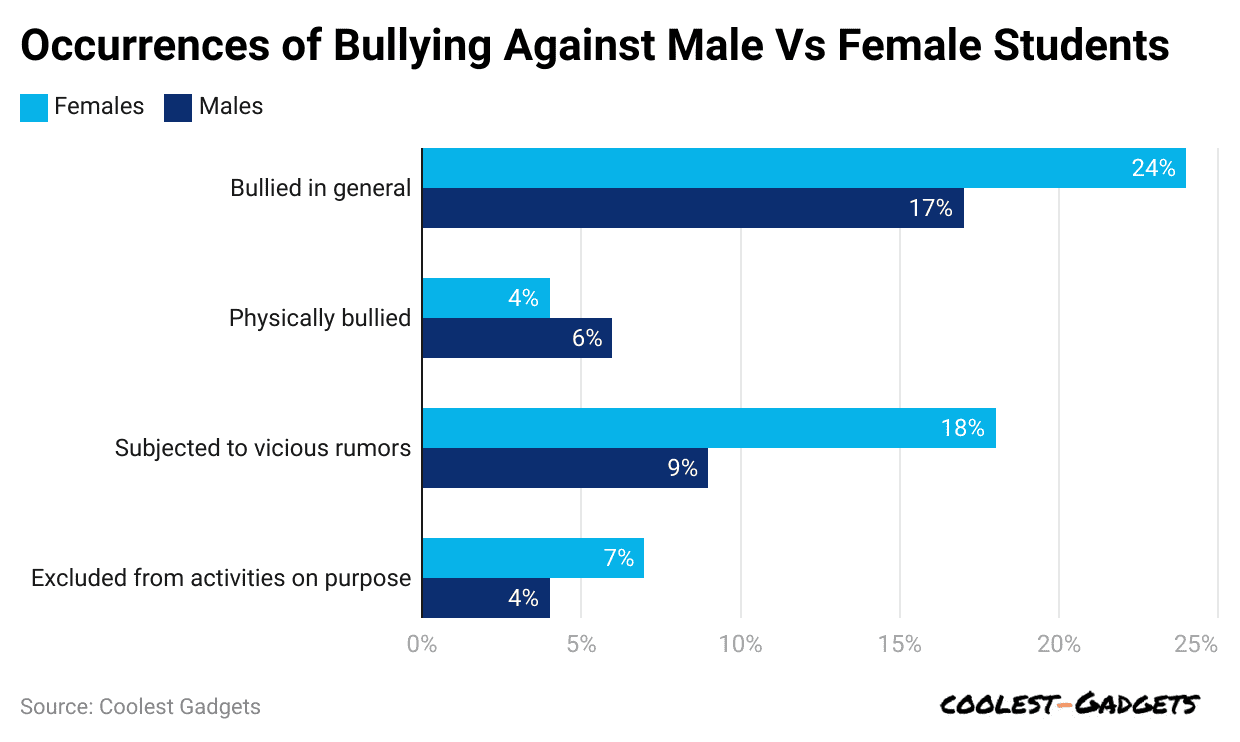 (Source: research.com)
(Source: research.com)
#2. Separation/Distance from Family
- More than 30% of U.S. college students feel homesick, with first-year students struggling the most—69% say they experience strong feelings of missing home.
- Among international students in the U.S., 92% say they miss home while studying abroad.
- About 57% of these students say they long for familiar sights, smells, and experiences.
- 74% say they miss the sounds of their hometowns, including:
- 50% miss hearing people speak their native language
- Student Stress Statistics stated that almost 26% miss the hustle and bustle of their community
- 25% miss the sounds of public transportation
- 20% miss local wildlife sounds
- Being far from home can be challenging for many students, especially when adjusting to a new environment, culture, and daily routine.
#3. Student Loans and Financial Concerns
- The average yearly cost of attending a public four-year college in the U.S. is over $20,000, while private universities cost $40,000 or more per year.
- Due to money struggles, 32% of students say they sometimes have trouble focusing on their studies.
- 60% of college students worry about not having enough money to cover tuition and other expenses.
- Some schools offer more budget-friendly degree programs, such as affordable online MSW programs, which can help ease financial worries.
- Student Stress Statistics stated that almost 70% of students feel stressed about their finances.
- 43% of full-time students and 81% of part-time students work while studying to help pay for college.
- 64% of students take out loans to pay for their education.
- Among students with student debt:
- 33% owe less than $10,000
- 20% owe more than $30,000
- Because of student loans, nearly 30% of students have taken fewer classes, 16% have paused their education, and 13% have switched to a more affordable school.
- Paying for college is a big challenge, and financial stress often affects students’ academic success and mental well-being.
 (Reference: research.com)
(Reference: research.com)
#4. Mental Health Challenges Among U.S. Students
- The number of American students dealing with suicidal thoughts or other suicide-related issues jumped by 47% from 2008 to 2017, rising from 7% to 10.3%.
- More than half (54.2%) of mental health professionals say that anxiety, depression, and stress are the biggest mental health challenges for college students.
- According to the Anxiety and Depression Association of America, 80% of students report feeling stressed frequently, while 34% struggle with depression.
- These mental health struggles affect students’ academic success, daily life, and overall well-being, highlighting the need for better support systems and resources.
#5. Coronavirus- related stress
- According to UNESCO, in March 2020, 87% of students worldwide—about 1.5 billion learners in 165 countries—were affected by school closures.
- A survey in April 2020 found that 20% of U.S. college students said their mental health got worse due to the pandemic.
- Student Stress Statistics stated that almost 78% of American households with high school or college students reported learning disruptions caused by COVID-19. Among them, 80% felt more stressed because of these changes.
- 44% of U.S. college students worried about whether they could stay enrolled or return to school during the pandemic.
- 69% of students who experienced learning disruptions believed their schools provided enough support to help them adjust.
- The pandemic caused major challenges in education, mental health, and finances, showing the need for better learning support during difficult times.
High School Students Bullying Statistics
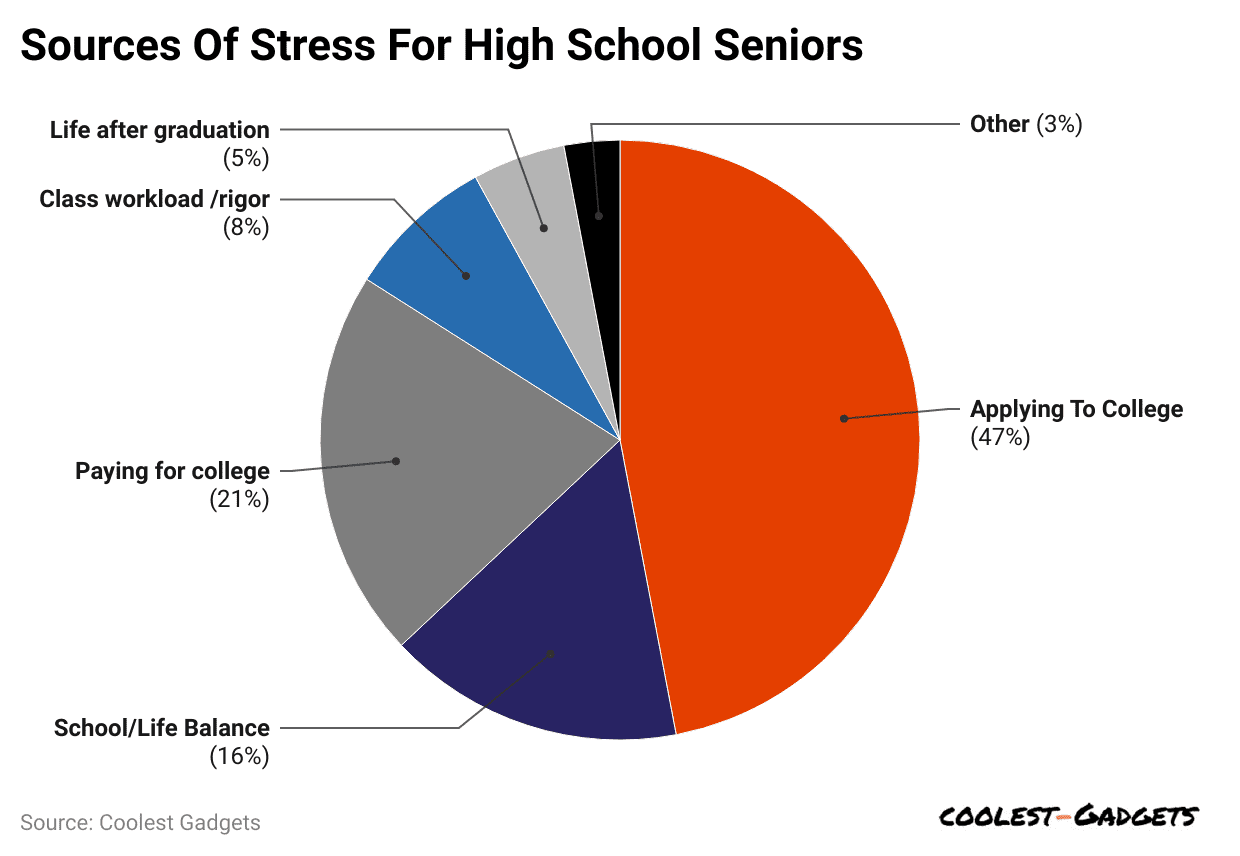 (Source: collegedata.com)
(Source: collegedata.com)
| Type of Bullying | Percent of High School Student |
|
Cyber |
18.6% |
| Physical |
27.3% |
|
Social |
56.2% |
| Verbal |
67.7% |
- 7% of U.S. high school students were victims of online bullying between 2018 and 2019.
- Female high school students are twice as likely to be bullied as males.
- In the past year, 20% of teenage girls said they had been bullied on the internet.
- 60% of high school bullying happens through social media apps like Facebook, Instagram, TikTok, and Twitter, along with text messaging.
- Around 160,000 teens have skipped school at least once due to bullying.
- Student Stress Statistics stated that almost 36.5% of middle and high school students have been victims of cyberbullying.
- 1 in 5 U.S. teens has been bullied in some way.
- Among 41 school shooters, 46% had been bullied either in school or online.
- 15% of middle and high school students admitted to bullying others online.
- More than half (55%) of public school students and nearly three-fourths (72%) of private school students feel that bullying affects their reputation among peers.
- 41% of bullied students believe they will be bullied again in the future.
- When someone intervenes to stop bullying, the harassment ends nearly 57% of the time right away.
- These numbers highlight how cyberbullying is a serious issue, affecting students’ mental well-being, education, and confidence.
Common Health Conditions in College Students Statistics
Mental health struggles like anxiety and depression are very common among college students. According to a survey by the American College Health Association (ACHA):
- 36% of students have been diagnosed with anxiety.
- 28% have been diagnosed with depression.
- 8% have been diagnosed with stress-related conditions, including PTSD.
- Many students also deal with other mental health challenges, making emotional well-being a serious issue on college campuses.
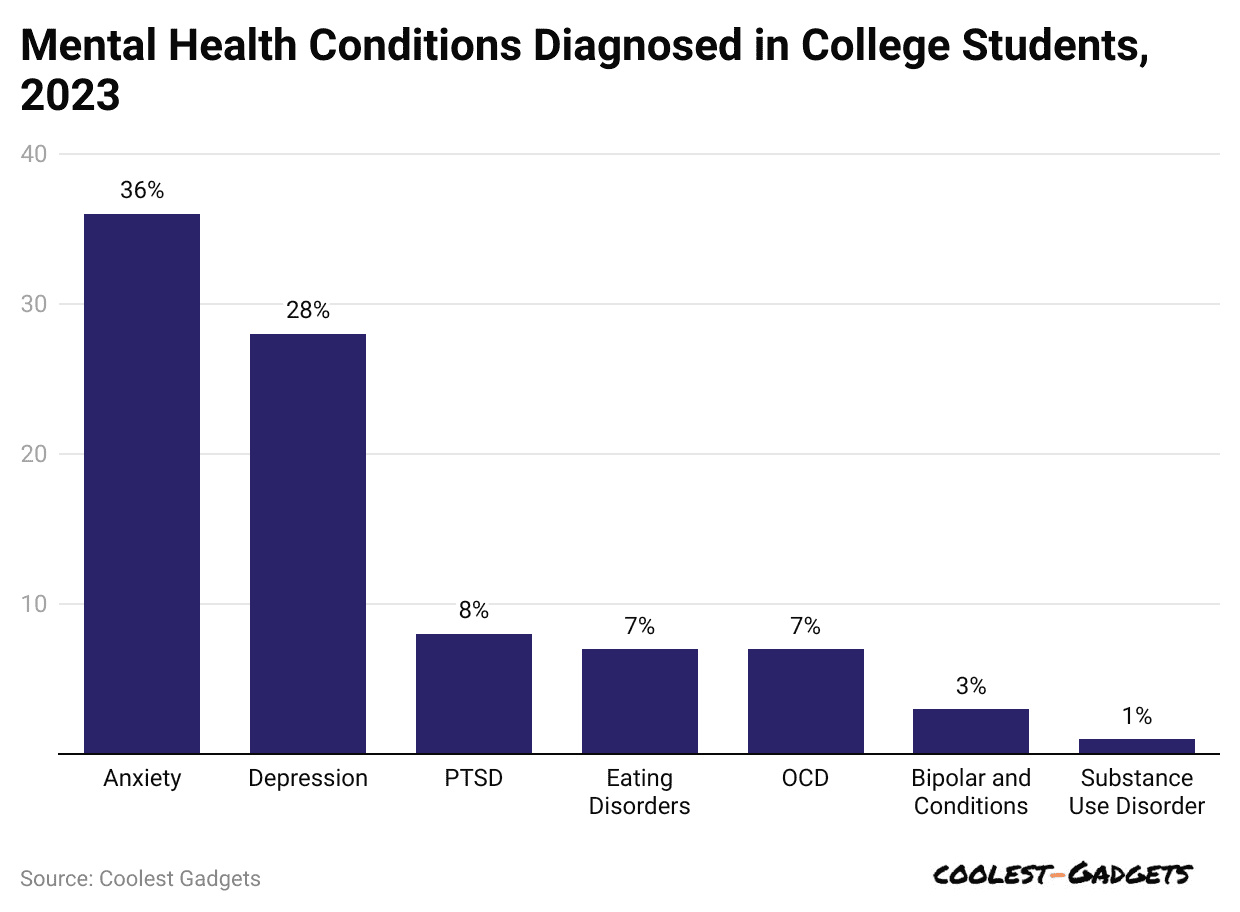 (Reference: bestcolleges.com)
(Reference: bestcolleges.com)
#1. Anxiety
Feeling anxious is a normal reaction to stress, but anxiety disorders can make it hard for students to focus on their daily activities.
- Student Stress Statistics stated that almost 36% of college students have been diagnosed with anxiety.
- 33% say anxiety has negatively affected their schoolwork in the past year.
- 4% say anxiety has slowed down their progress toward graduation.
- 77% of students with anxiety have talked to a doctor or counsellor about it in the past year.
How students manage anxiety:
- 47% use both medication and therapy.
- 26% rely only on therapy.
- 19% take medication without therapy.
- 7% do not use any treatment.
#2. Depression
Depression is a serious mood disorder that affects how a person feels, thinks, and acts.
- 28% of students have been diagnosed with depression or another mood disorder.
- 22% say depression has negatively affected their academic performance in the past year.
- 5% say depression has slowed down their progress toward graduation.
- Student Stress Statistics stated that almost 77% of students with depression have spoken to a doctor or counsellor in the past year.
How students manage depression:
- Nearly 54% use both medication and therapy.
- Around 22% rely only on therapy.
- 18% take medication without therapy.
- 5% do not use any treatment.
#3. Trauma and Stress-Related Disorders
Students who experience traumatic events may develop disorders like PTSD (Post-Traumatic Stress Disorder), acute stress disorder, or adjustment disorder.
- 8% of students have been diagnosed with a trauma or stress-related disorder.
- Student Stress Statistics stated that almost 3% say their condition has negatively affected their schoolwork in the past year.
- 1% say it has slowed their progress toward graduation.
- 73% of students with trauma-related disorders have talked to a healthcare professional in the past year.
How students manage trauma-related disorders:
- 46% use only therapy.
- 41% use both medication and therapy.
- 5% take medication without therapy.
- 7% do not use any treatment.
#4. Eating Disorders
Eating disorders like anorexia, bulimia, and binge eating disorder cause unhealthy eating habits and obsessive thoughts about food and weight.
- 7% of students have been diagnosed with an eating disorder.
- Student Stress Statistics stated that almost 4% say their eating disorder has negatively affected their academic performance.
- 56% of students with an eating disorder have talked to a doctor or counsellor in the past year.
How students manage eating disorders:
- 57% use only therapy.
- 19% use both medication and therapy.
- 19% do not use any treatment.
- 3% take medication without therapy.
Undiagnosed Eating Disorders:
- 14% of students likely have an eating disorder but have not been diagnosed.
- Student Stress Statistics stated that almost 30% say they feel they need to be very thin to feel good about themselves.
#5. Obsessive-Compulsive Disorder (OCD)
OCD causes people to have unwanted thoughts (obsessions) and feel the need to repeat actions (compulsions).
- 7% of students have been diagnosed with OCD or a similar condition.
- 67% have spoken to a healthcare professional about it in the past year.
How students manage OCD:
- 45% use both medication and therapy.
- 32% rely only on therapy.
- 12% take medication without therapy.
- 10% do not use any treatment.
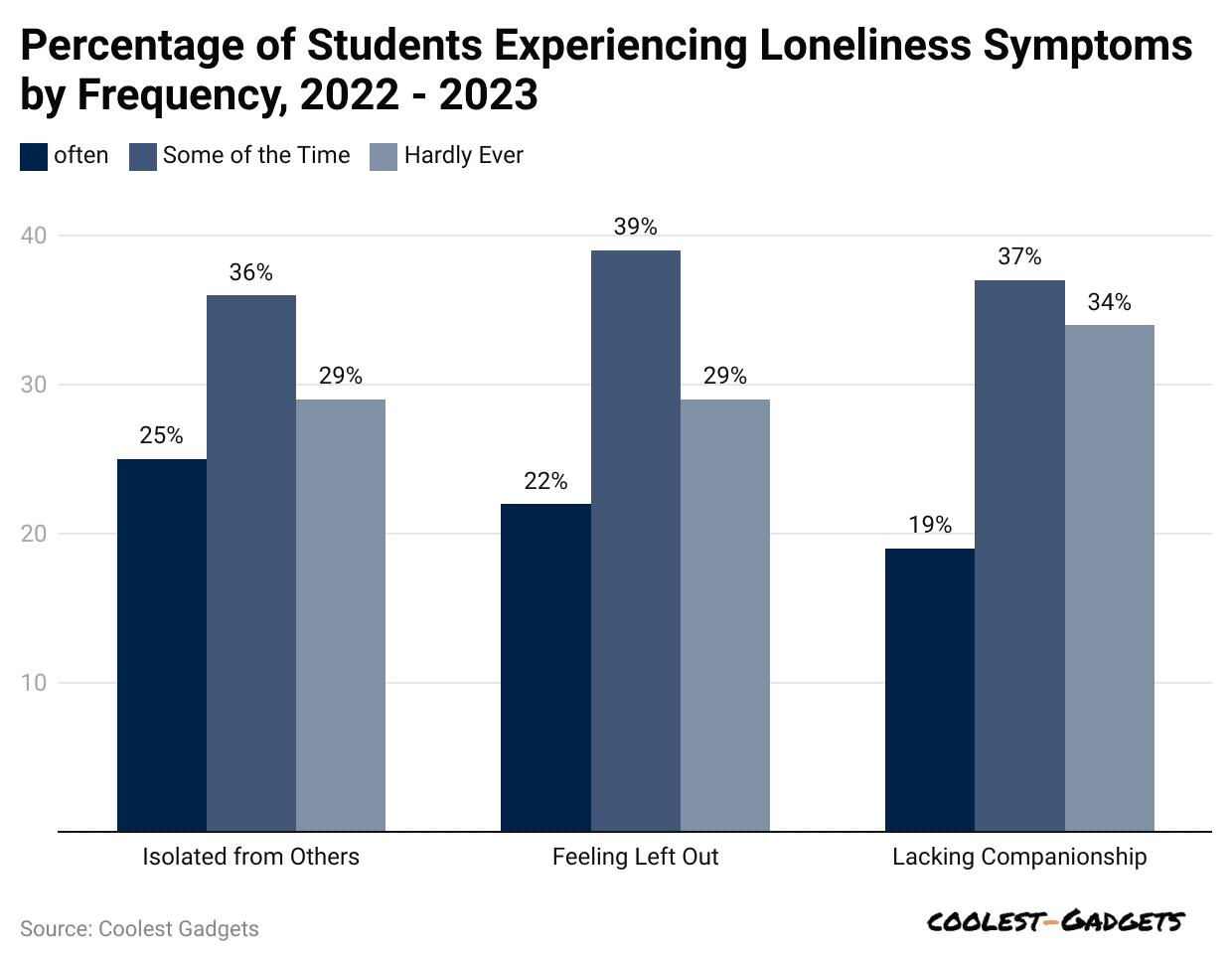 (Reference: bestcolleges.com)
(Reference: bestcolleges.com)
#6. Bipolar Disorder
Bipolar disorder causes extreme mood swings, ranging from high energy to deep exhaustion.
- Student Stress Statistics stated that almost 3% of students have been diagnosed with Bipolar I, Bipolar II, or hypomania.
- 74% have talked to a healthcare professional about their condition in the past year.
How students manage bipolar disorder:
- 64% use both medication and therapy.
- 18% take medication without therapy.
- 11% rely only on therapy.
- 6% do not use any treatment.
#7. Substance Use Disorders (Addiction)
Students with substance use disorders may struggle to control their use of drugs or alcohol, which can interfere with school and relationships.
- Just over 1% of students have been diagnosed with addiction or substance abuse.
- Student Stress Statistics stated that almost 45% had seen a doctor or counsellor for their condition in the past year.
How students manage substance use disorders:
- 56% use only therapy.
- 18% use both medication and therapy.
- 2% take medication without therapy.
- 16% do not use any treatment.
Gender Differences in Stress Levels Statistics
- Studies show that stress levels in college vary by gender, with female students often feeling more stressed than male students.
- Women in college generally report higher stress levels compared to men. According to research from NCBI, females rely more on emotional coping methods, such as:
-
- Keeping themselves busy to avoid stress
- Seeking emotional support from friends or family
- Asking for help when they need it
- Expressing their emotions openly
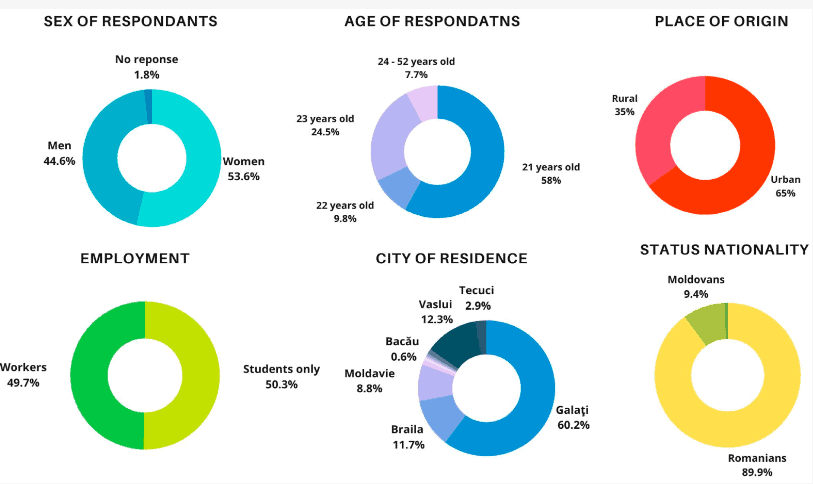 (Source: mdpi.com)
(Source: mdpi.com)
- A report from Frontiers in Psychology also found that women are more likely than men to experience stress, anxiety, depression, and substance use problems, with stress being the most common issue.
- 72% of female students felt stressed the day before the survey.
- Student Stress Statistics stated that almost 56% reported feeling worried that same day.
- Female students also tend to use problem-solving strategies that involve seeking social support. However, as NCBI notes, some studies disagree on whether men and women actually cope differently.
- While men in college generally report lower stress levels than women, many still struggle with stress.
- 56% of male students felt stressed the previous day.
- 40% said they felt worried that same day.
- 2% of college students said stress was their biggest challenge in learning.
- 3% reported feeling more stressed than usual.
- These numbers show that colleges should offer stress management programs tailored to the needs of both male and female students.
- By understanding how stress affects students differently, schools can provide better mental health support and help students succeed academically.
How Social Media Increases Stress Among Students
Social media affects students’ mental health, confidence, and school performance, often adding to their stress. Below are some ways it impacts them:
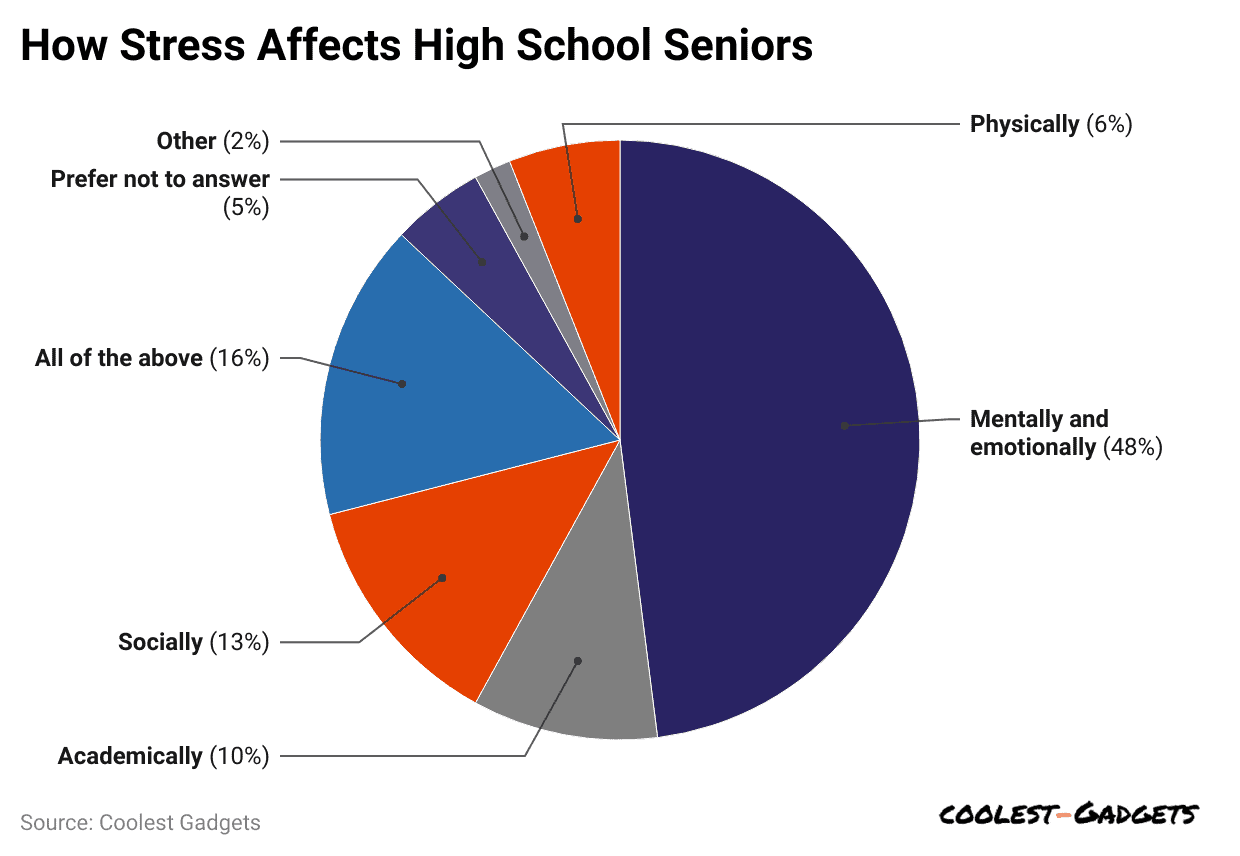 (Reference: collegedata.com)
(Reference: collegedata.com)
- . Online Bullying (Cyberbullying)
A lot of students face bullying on social media through mean comments, private messages, or posts. This can lead to stress, sadness, and even skipping school or avoiding social situations.
- Comparing to Others
People usually post the best parts of their lives on social media, making students compare themselves. This can cause low self-confidence and stress, especially if they feel they aren’t doing as well as their friends.
- Fear of Missing Out (FOMO)
When students see others going to events or achieving goals, they may feel left out or pressured to keep up. This can lead to constant online checking and increased anxiety.
- Schoolwork Distractions
Spending too much time on social media takes away from studying, causing delays in completing assignments and higher stress when deadlines get close.
- Poor Sleep Habits
Many students use social media late at night, which disrupts their sleep schedule. Not getting enough rest can increase stress and harm both mental and physical health.
- Pressure to Look Perfect
Social media often makes students feel like they need to look perfect online, leading to stress and fear of being judged if they don’t match social standards.
- Seeing Upsetting Content
Students may come across disturbing news, violent images, or discussions about serious topics, which can cause stress and anxiety.
Methods Used by Students to Reduce Stress
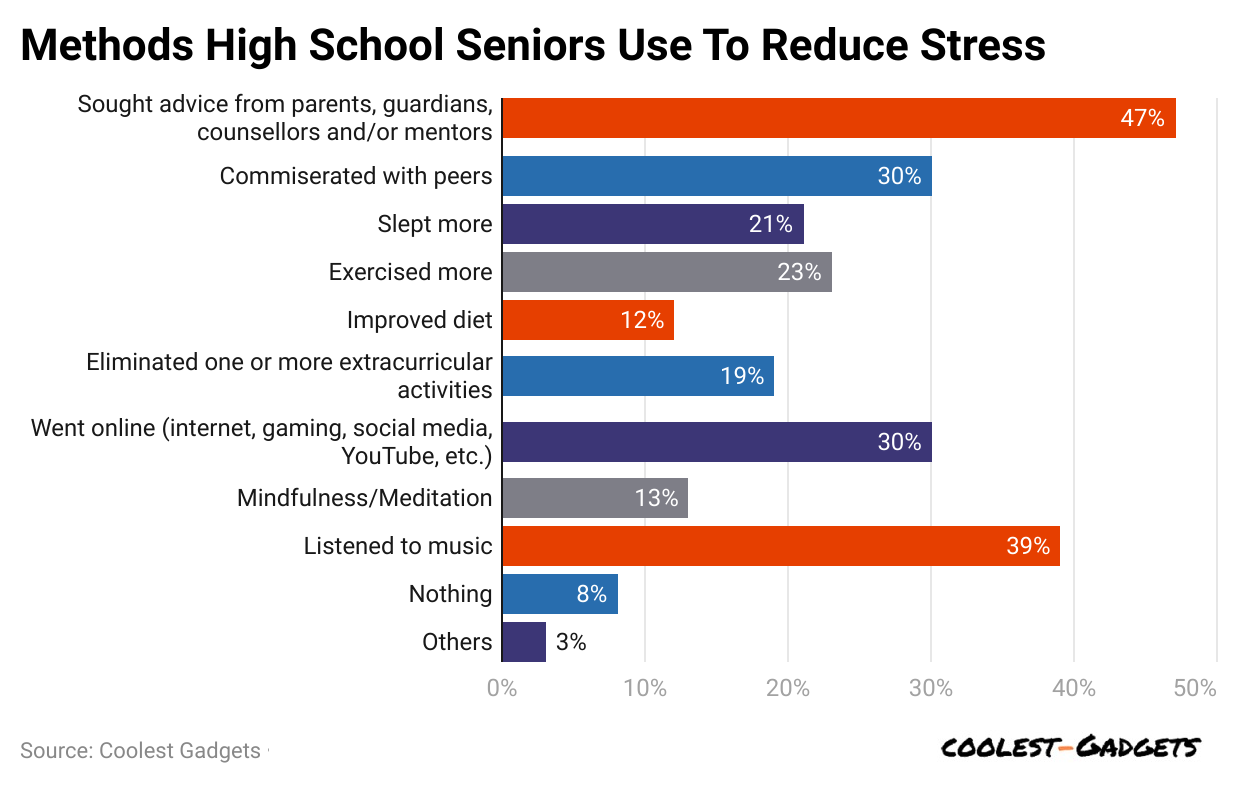 (Reference: collegedata.com)
(Reference: collegedata.com)
| Methods | % |
| Sought advice from parents, guardians, counsellors and/or mentors |
47% |
|
Commiserated with peers |
30% |
| Slept more |
21% |
|
Exercised more |
23% |
| Improved diet |
12% |
|
Eliminated one or more extracurricular activities |
19% |
| Went online (internet, gaming, social media, YouTube, etc.) |
30% |
|
Mindfulness/Meditation |
13% |
| Listened to music |
39% |
|
Nothing |
8% |
| Others |
3% |
Conclusion
These facts show that many students deal with high stress, which affects their minds and bodies. To help them, it’s important to find out what causes stress and give them the right support. Schools, families, and leaders need to work together to build a positive and helpful environment where students can concentrate on learning and staying healthy.
By offering mental health support, stress-relief programs, and a balanced workload, students can have a better and more successful school experience. We have shed enough light on Student Stress Statistics through this article.
Sources
FAQ.
About 70% of teenagers in the U.S. (ages 13-17) believe that anxiety and depression are major problems among their friends. Around 75% of high school students say they often feel bored, angry, sad, scared, or stressed while at school. When rating stress levels on a scale of 1 to 10, American teens report an average of 5.8, while adults rate theirs lower at 3.8.
The U.S. has the highest number of stressed students in the world. While some causes of stress are easy to understand, others are less obvious. Many students feel pressure not just from schoolwork but also from issues like crime and bullying.

Barry Elad is a tech enthusiast passionate about exploring various technology topics. He collects key statistics and facts to make tech easier to understand. Barry focuses on software and its benefits for everyday life. In his free time, he enjoys creating healthy recipes, practicing yoga, meditating, and walking in nature with his child. Barry's mission is to simplify complex tech information for everyone.




